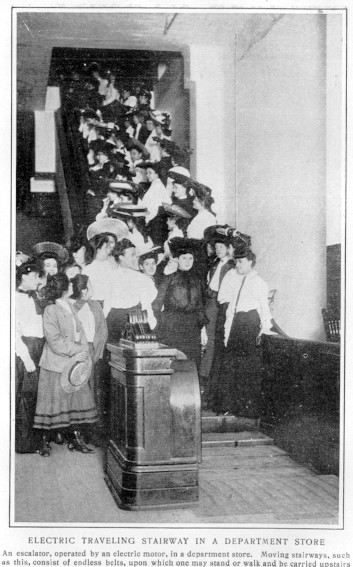Magic Stairways
Today, a magic stairway carries us into a new way of life. The University of Houston's College of Engineering presents this series about the machines that make our civilization run, and the people whose ingenuity created them.
Escalators were rare when I was young. In the 1930s it was heady adventure for a five-year-old to visit the one department store downtown that had one. Yet the idea wasn't new. An escalator that had most of the features of the modern ones was patented in 1859. It even had that comblike structure to let the steps emerge out of the floor and vanish back into it.
What we didn't have until the 1880s were electric motors to drive escalators. Steam-driven elevators were around in 1859, but who would install a whole steam engine just to drive a stair way! Besides, escalators make sense only when you want to move a lot of people. Mid-19th-century buildings weren't more than seven stories high. It's only when buildings are very high that you have to move a lot of people in the lower stories.
So escalators lay fallow until the 1890s. Then a spate of electric-powered moving stairways appeared. The first one was built in 1896 when Jesse Reno made a little 6-foot stairway that lifted people on to the Coney Island pier. Then, just four years later, the 1900 Paris Exhibition displayed four different kinds of escalators -- including Reno's. Escalators were catchy, but they were still a fairground ride, not a functional necessity.
The Coney Island success made Reno into America's leading escalator designer. From Coney Island his machines went into New York department stores and then into the Boston subways. The Otis Elevator Company bought Reno out; but the whole enterprise didn't reach much beyond novelty. By 1920 no escalator company operated more than 200 units.
Finally the Otis company sorted through the features of competing systems. They sifted out the best ones and made what's been the standard escalator ever since -- a machine that can carry 8000 people an hour up a 30x slope. Only then did escalators start to become commonplace. Only then did escalators show us their real role in our lives. They aren't so much labor savers as they are space savers. They keep people moving in crowded public places -- like subway stations and the lower floors of high-rise buildings.
Yet the old Reno escalator was a solid piece of equipment, and many are still in use. You can spot them in the Boston and London subway systems. They have a characteristic structure of wooden slats that make up their treads and risers.
When I was five, being swept up the stairs was high adventure. I didn't know I was seeing a convergence of techniques that was taking us into modern, high-density city life.
I'm John Lienhard, at the University of Houston, where we're interested in the way inventive minds work.
(Theme music)
Worthington,W.Jr., Early Risers. American Heritage of Invention and Technology, Winter, 1989, pp. 40-44.

This 1904 book on electricity celebrates an early department store escalator